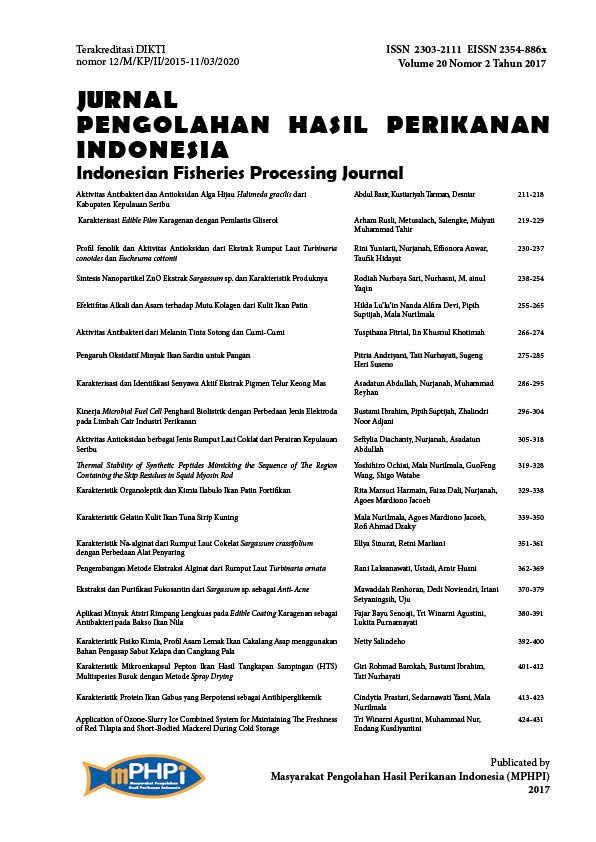Characterization of snakehead fish protein that’s potential as antihyperglikemik
Abstract
Snakehead fish has been sources that have high protein content and can be used as antioxidant and anti-diabetes. To increase the level of protein content and amino acid in snakehead fish, the treatment of hydrolysis and fermentation were chosen in this study. Therefore, the purpose of this study was to evaluate the characteristics of snakehead fish protein and its potential as antihyperglycemic. Three samples were used in this study, i.e., hydrolysate, fermented and non-fermented isolates. The experimental design used was completely randomized design. Data were analyzed by analysis of variance (ANOVA) and continued by Duncan multiple range test (DMRT) (α = 5%). The current study reported that the hydrolysate had higher
protein content 90.43%, as compared to the fermented and non-fermented isolates were 84.43% and 78.69%, respectively. At a concentration of 10.000 ppm, hydrolysate showed highest inhibition activity (74%), as compared to fermented isolate inhibited 59% and none-fermentation isolate inhibited 56%. Hydrolysate also had higher amino acid content than fermented and non-fermented isolates of 51.15, 44.34, and 32.00 %w/w, respectively. Hydrolysate had the lowest molecular weight (<10 kDa), while fermented and non-fermented isolates were <10 kDa. This probably due to the hydrolysis process using an enzyme was capable to break the peptide fractions of snakehead fish protein. Hence, it increased the levels of protein, amino acids, there by protein hydrolysate had high inhibitory potential than fermented and non-fermented isolates.
protein content 90.43%, as compared to the fermented and non-fermented isolates were 84.43% and 78.69%, respectively. At a concentration of 10.000 ppm, hydrolysate showed highest inhibition activity (74%), as compared to fermented isolate inhibited 59% and none-fermentation isolate inhibited 56%. Hydrolysate also had higher amino acid content than fermented and non-fermented isolates of 51.15, 44.34, and 32.00 %w/w, respectively. Hydrolysate had the lowest molecular weight (<10 kDa), while fermented and non-fermented isolates were <10 kDa. This probably due to the hydrolysis process using an enzyme was capable to break the peptide fractions of snakehead fish protein. Hence, it increased the levels of protein, amino acids, there by protein hydrolysate had high inhibitory potential than fermented and non-fermented isolates.
Authors
PrastariC., YasniS., & NurilmalaM. (2017). Characterization of snakehead fish protein that’s potential as antihyperglikemik. Jurnal Pengolahan Hasil Perikanan Indonesia, 20(2), 413-423. https://doi.org/10.17844/jphpi.v20i2.18109
Authors who publish with this journal agree to the following terms:
- Authors retain copyright and grant the journal right of first publication with the work simultaneously licensed under a Creative Commons Attribution License that allows others to share the work with an acknowledgement of the work's authorship and initial publication in this journal.
- Authors are able to enter into separate, additional contractual arrangements for the non-exclusive distribution of the journal's published version of the work (e.g., post it to an institutional repository or publish it in a book), with an acknowledgement of its initial publication in this journal.





